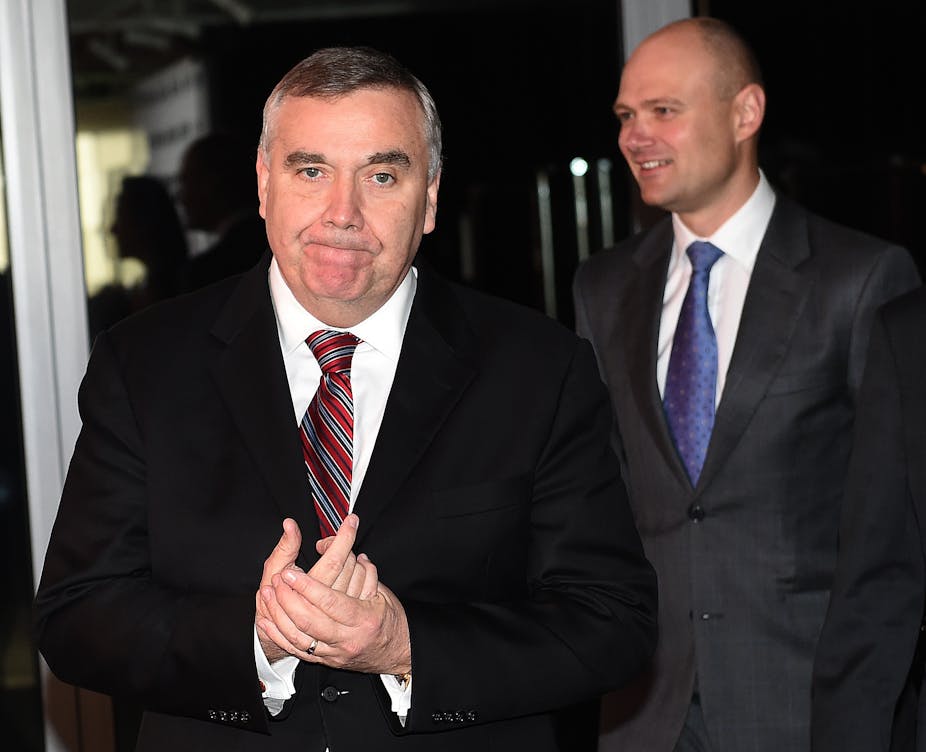In this reporting season it would be hard to find two companies more different than well-known Australian airline Qantas and retailing giant Myer.
The half-yearly Qantas result exceeded the rosiest expectations of most analysts. Most notable has been the pace of the company’s turnaround as it was only a year ago that its management sought some form of bailout from the Commonwealth.
Qantas’ CEO, the taciturn Irishman Alan Joyce, attributes the sudden change of fortunes to his own strategy of cost reduction. The reality is somewhat more complex.
While the airline was facing the proverbial “perfect storm” of competitive and cost pressures in 2013, 2014 has been perfectly benign – plummeting oil prices, a declining Australian dollar and a local competitor (Virgin Australia) becoming much less aggressive in local and international markets. It seems that Virgin and Qantas have learnt the hard way that duopolists maximise profits by slugging customers – not one another. But they have learnt.
The story at Myer, however, is pretty much all bad. The market capitalisation of the currently listed firm now sits below A$1 billion – around two thirds what the private equity firm Newbridge Capital paid for it in 2006. Its share price is barely 40% of the IPO price of A$4.10 paid by investors in late 2009. This week Myer chief Bernie Brookes joined the long list of senior executives to resign from the company since 2010.
The pundits are predicting that the half-year results, due on March 19, will be a shocker.
Managing for growth
Unlike Qantas, Myer has followed a growth strategy since 2006 – opening more than a dozen new stores – including some in unlikely places (for example, Maitland and Mackay). Myer’s management seemed intent on taking on the naysayers who said the large format department store was dead in the face of e-commerce. If Myer’s loss is half as bad as speculation suggests, it will be evidence that the naysayers had a point after all.
Leaving aside the peculiarities of these two stories, some bigger questions emerge. In the dynamic and uncertain economy of 2015 – should firms seek to improve performance through cost reduction or through growth? Like any good question that even slightly impinges in the economic domain, the answer is simple - it all depends.
The problem for Myer is that the wider environment (that encapsulates changes in technology and freer trade, as well as emerging consumer tastes) is fully against the Myer retail model. Myer’s customers are voting with their feet, and more pertinently their computer mice, as e-commerce in Australia takes off.
Had Myer followed a more cautious approach – would it be in the mess that it is today? The answer is probably, but most likely not as deeply. With the benefit of hindsight, the rush to grow new stores when the world was moving away from Myer’s business model was rash.
For Qantas, cutting costs has been part of the story of its improved fortunes, but the real improvements have had little to do with management decisions. Lower oil prices go straight to the airline’s bottom line and a lower Australian dollar sees more Australians holiday at home – and Qantas’ real strength lies in its dominant position in the increasingly cosy domestic duopoly it shares with Virgin Australia.
The domestic duopoly, in turn, is sustained by some very practical barriers to entry relating to airport facilities and landing slots that make Qantas’ local operations a perennial profit maker.
It would be quite something for Qantas to let this domestic cash cow wither. Indeed, even as Qantas cut costs, it had an eye on maintaining the quality of service it provides to the real heroes of its story – the business travellers whose employers pay upwards of A$1500 for a return ticket between Sydney and Melbourne.
There are some shared lessons, however, from these tales of two very different results.
Playing to strengths
First, firms need to know what they are good at and what will sustain their performance.
These need not be the same thing – the problem for Myer is that it is quite good at doing things that customers no longer want. In strategic management - we call these core rigidities - Qantas, on the other hand, understands its key strategic capability – moving price-insensitive business travellers between our distant major cities.
Second, very few firms can change the world. Perhaps Apple is an exception – it is a firm that has changed the way we use information technology. Qantas and Myer, on the other hand, are highly susceptible to changing tastes, technologies and competitive realities.
Finally, the times suit Qantas – but they probably won’t for long. The fundamental realities of the airline industry make it liable to wear all sorts of exogenous shocks – from terrorism, other disasters, fuel price shocks and subsidised international competitors (and the list goes on). The investors piling into Qantas at its current inflated prices would do well to remember this.
Will the times ever again suit Myer? Probably not. The changes impacting its business model seem to be accelerating, rather than receding. The decline of America’s shopping malls is a trend Australia looks likely to follow. As the malls close, so will their tenants like Myer. The large format department store seems doomed to fail. Perhaps the best strategy for Myer is to manage its decline with grace.

